Every March, something magical happens in my high school in Venice. Students clothed in suits to become delegates, classrooms become commissions, desks are covered and become delegations. MUNs (or Model United Nations) unite many students from all backgrounds and cultures in the initiative of diplomacy. I’m proud to say that my school annually host one of these initiatives. Student-run and organized, teacher overseen.
This year, I had the amazing opportunity to fill the position of judge in the International Court of Justice – I say this humbly because due to its linguistic complexity, the ICJ almost requires a mother-tongue English speaker to preside over it, and so I was actually elected from a selection pool of one. The court undertook a case whose goal was to question the freedom of a country such as the United States of America in undertaking an “anti-earth” economic and political policy, and the possibility of other countries putting the USA back in line. After months of preparation and three intense days of debate, it became increasingly clear to the courtroom and to myself that we currently live in a world where the self-interest of very few can prevail, unchecked, over the needs and desires of many.
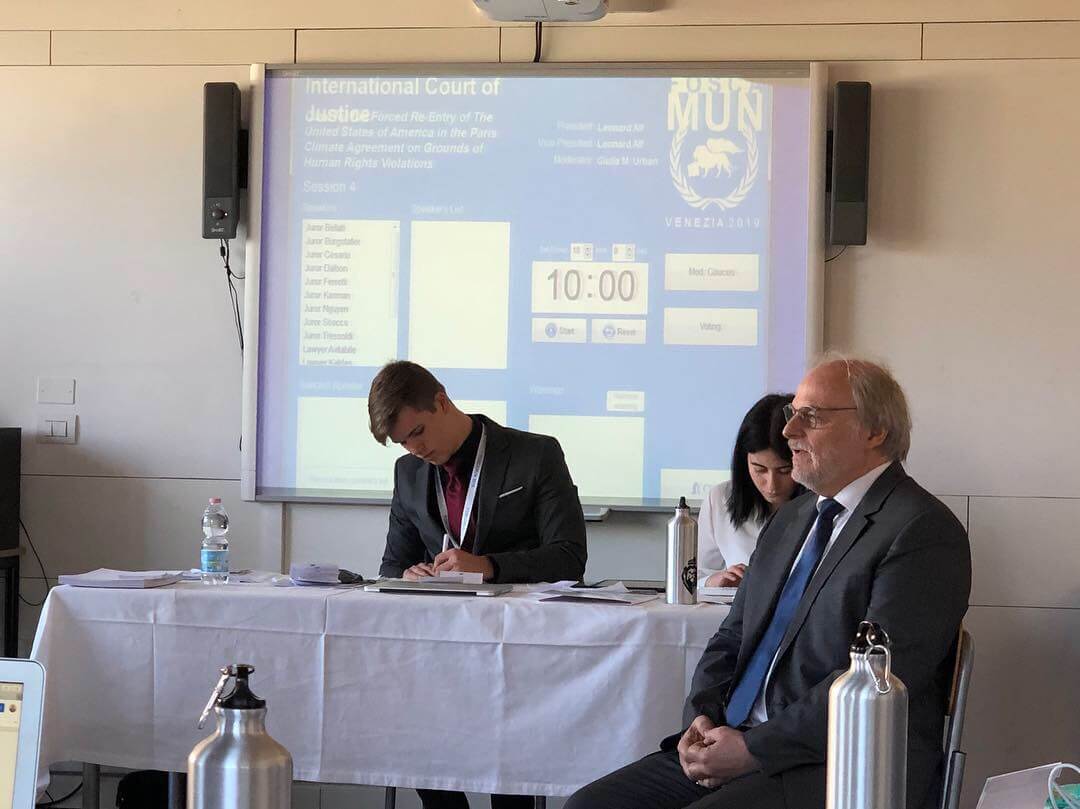
To say that I lost faith in the UN’s ability to guide us towards a greener and better future would be an understatement. I came to see the stark reality of the political climate we now live in. Despite all the positive steps we have taken forward in reducing poverty and famine, and doing away with so much discrimination and gender/ethnically based oppression, we now live in a world where many remain voiceless. Particularly those still living in extreme poverty, and generations to come who will have to live with the consequences of our actions today. If the latter party could speak to us today I believe they would ask us why we are poisoning our earth, despite the undeniable evidence of how doing so will affect living beings in the future.
That is why I came to the conclusion that if a change is going to be made, on the necessary scale to prevent “the preventable”, it will have to come from an individual level, rather than from a statewide, or international one. If a future of green fields and blue skies exists, free from famines, plagues, and war, it will not come to fruition because of the UN, the United States of America, or even self-proclaimed “green companies” such as Tesla and Solar City, but rather from a new generation of bold politicians, radical business leaders, entrepreneurs who can create entirely new markets and industries of the 21st century which are different to those of the 20th Century – which offer sustainable ways of living building a better society, to use the wise words of Professor and author Stephen Emmott. Furthermore, all these individuals will have to share a common ideal, which they work towards, in order for there to be the necessary cooperation and scale to actually make a change. I’ve taken upon myself to imagine what that future might look like and how we will get there.
The World We Live In Today
We live in interesting times. The next hundred years will see an amount of change unprecedented in the history of civilization. Of course, we naturally gravitate towards the belief that things will remain as they were in the past and thus live in a state of willful blindness best summed up by the maxim “Ignorance is bliss.”
The truth we all have to face however is a bitter one. There is indeed a 600-pound gorilla in the room, an elephant under the carpet, a skeleton in the closet: the actual reality of a much warmer earth. What research shows us is a world vastly different from the one we live in today. Much hotter, with massive shortages of food and water (enough to affect billions), unbreathable air, poisoned oceans, perpetual war, and permanent environmental collapse. A literal “hell on earth.” And this hell is expected to come into fruition within our lifetimes if we do not change our ways. Research does not only show us the effects of our actions, it shows us, incontrovertibly, that our climate does not change gradually. The world as we know it can fall apart in one generation. And if we do not change, that generation will be mine, or even worst, I feel, that of my children.
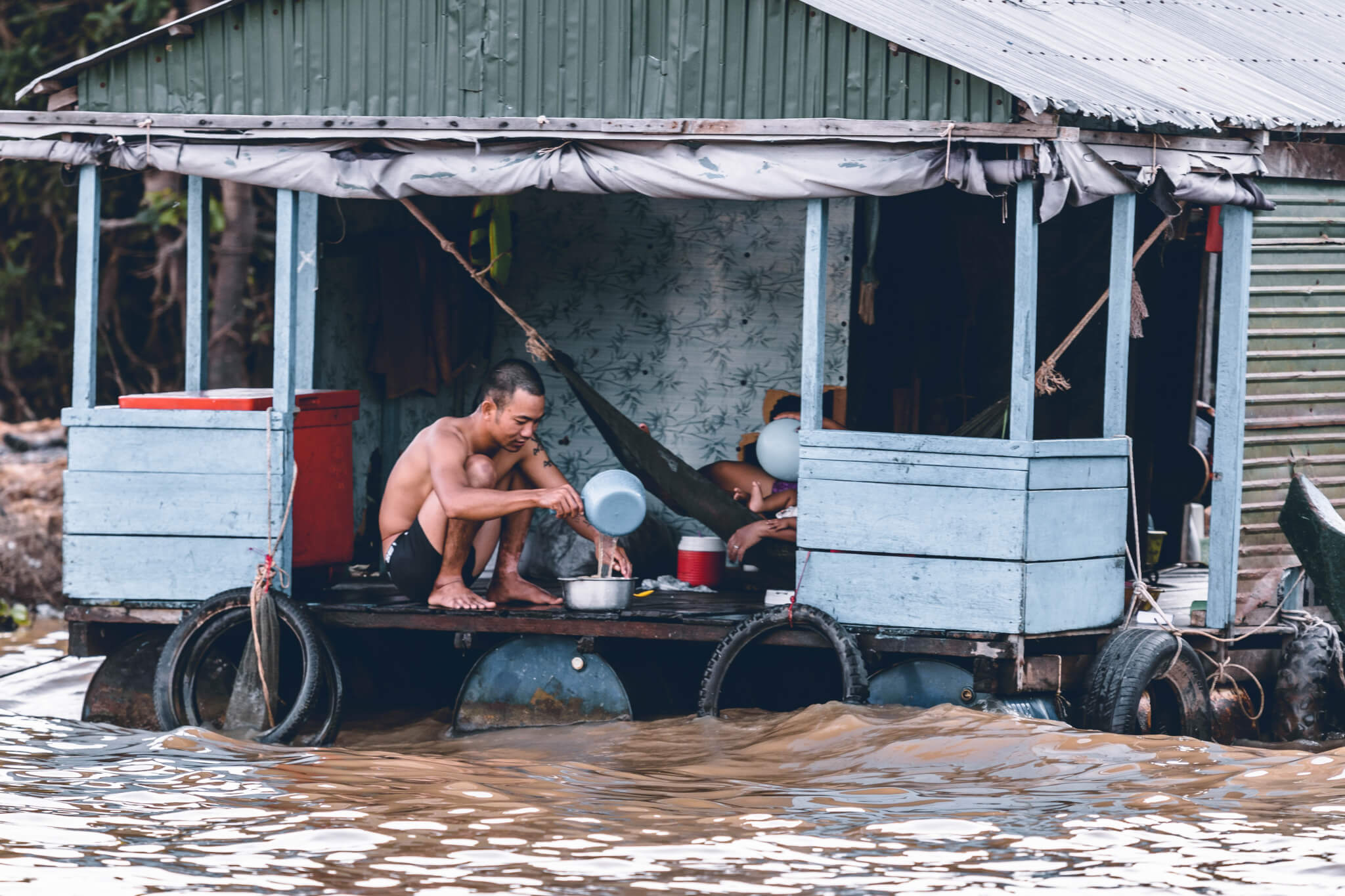
Generally, it has been a human tendency to prioritize the present over the future. We seize the opportunity to advantage ourselves at other’s expense when the opportunity arises. In the seventeen-hundreds, at the beginning of the industrial revolution, manufacturers discovered new and more efficient ways of production. There seemed to be no backside: you put coal inside a machine, turned it on, and it worked much cheaper, faster, and reliably than manual labor. In retrospect, it is pretty obvious that the economic gain created with these technologies came at a very steep price: the release of billions of tons of carbon into the atmosphere. Seen in this light, the immense riches that sprung forth from the industrial revolution in Europe, and more recently in North America and Asia, are less wealth creation through technology and more a withdrawal from the “environment bank”. Carbon-based fuels supply the equivalent of billions of slaves, working 24 hours per day, and created the massive amounts of wealth which allowed the global population to skyrocket from 1.6 to almost 8 billion people in under a century. It’s a withdrawal started hundreds of years ago that we are only beginning to pay back, with interest.
And yet it is self-evident that this environmental bank still has more money to loan. That will be the case just as long as there are more resources to extract and burn. And unfortunately, human nature is such that it is unlikely that these withdrawals (in the form of carbon dioxide emissions) will cease to take place unless policies are created which strictly reinforce a level of greenhouse gas emission which is beneficial to future generations. The main obstacle to these policies is the direct correlation between greenhouse gas emissions and profit.
While it is possible to de-couple carbon emissions and economic profit, the two are definitely linked, as Goher-Ur-Rehman Mir observes in his 2016 article: “Carbon Emissions and Economic Growth: Production-based versus Consumption-based Evidence on Decoupling”. The scary truth is that the advent of fossil fuels should be viewed as a one-time injection into our economic system, rather than a permanent booster. Unlimited green growth is not possible. Breaking off our dependency on carbon will produce an inevitable reduction in wealth, but it is a burden we will have to face; our survival depends upon it.
A 2012 article in Rolling Stones by Bill Mckibben lays out a terrifying set of numbers. McKibben explains how the current oil reserves, containing over 2700 gigatons of fossil fuel, are estimated to be worth upwards of 27 trillion (with a “t”) US dollars. Most scientists concur that in order to stay under 2°C temperature increase compared to pre-industrial levels, which is according to climate scientist is the bottom line on temperature increase before total ecosystem disaster, we can only emit 565 gigatons, a fifth of what we have at our disposal. At our current rate of emission, we would go through that in merely 16 years. In that way, Saudi Aramco, Sinopec, ExxonMobil, and other fossil fuel companies, are directly profiting from destroying the ecosystem in a permanent way.
According to what stated previously, in order to avoid disastrous consequences for future generations, these companies would have to leave 80% of available fossil fuels in the ground, giving up roughly 20 trillion dollars of product. And yet just ExxonMobil, the USA’s biggest petrol company, invests over 100 million US$ a day in finding new oil deposits. The situation reminds me in a way of the abolitionist movement in 19th century America. Historians calculate the material value of all the slaves owned by plantation owners in the south before the American civil war to be close to 10 trillion dollars, adjusted for inflation. And it took four years and over 660.000 deaths before they gave up the ownership of their slaves.
This situation is different. Fossil fuel companies are massive and unbelievably rich. Furthermore, they have close ties to powerful governments. The very governments that are supposed to be taking care of their citizens and ensuring a future for their children! Must I remind readers that the former USA Secretary of State, Rex Tillerson, was also the CEO of ExxonMobil between 2006 and 2017? These companies are simply too powerful to be taken down and the only case in which they would leave petrol in the ground is if they did so voluntarily. I personally believe that is impossible, we as human beings are incapable of the self-control required to give up 20 trillion dollars, especially the likes of Tillerson, even if to do so is the only way to ensure long-term environmental sustainability.
To restate: if we burn all the fossil fuels at the current rate, it will all be used up in under a hundred years. And in just two generations we will have produced an environmental catastrophe which will still be felt in 3019, and 13019. Obviously, there is more at stake here than the billion people currently put at risk in developing countries, but much more. Unimaginably more. This century, if nothing changes, will be looked on the single pivotal moment in human history, ever. Biblical tales can’t even compare. The only way I can think of to call what we are doing, consciously or not is committing planetary suicide.
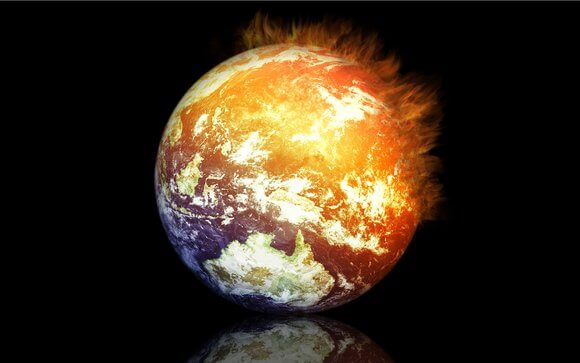
“YOU ONLY TALK ABOUT MOVING FORWARD WITH THE SAME BAD IDEAS THAT GOT US INTO THIS MESS, EVEN WHEN THE ONLY SENSIBLE THING TO DO IS PULL THE EMERGENCY BRAKE.”
–Greta Thunberg, youth climate activist, before the UN in December 2018
Having concluded that to reduce carbon emissions will produce inevitable economic decline, we have to look at how we are going to prosper in a less wealthy world – how we are going to feed, water, shelter, and heat the eight billion of us (and the two more billion [!!!] who are expected to be born by 2050), much less thrive, without the help of our best friend, and worst enemy, carbon. It should seem apparent to most that the way in which we live is going to have to be radically different. Our cities will look different because we will have to break our addiction to consumerism, as will our transportation systems. The products we use will look different; they will have to be built to last with durable and sustainable materials, and construction will have to be done locally so as to minimize the inevitable energy expenditure (wastage) associated with transcontinental shipping. Our generation will have to literally design an entirely different reality, and make some necessary sacrifices if we are going to survive and flourish as a species in the long term.
That being said, enormous resources are being spent today to do away with racism, xenophobia, sexism, rape and other correlated issues. I obviously support their eradication and it is painfully obvious to me that mistreatment of women skyrockets when a crisis hits (war, famine, drought, plague), as do all other issues of human rights and equality. And the crisis coming because of fossil fuel emissions will be unlike any other we have ever seen. No one will be able to protect the rights of women or transgender individuals during the predicted meltdown. Not when tens of millions die in the heat. Not when a hundred million homes go under water. Not when a billion people are starving.
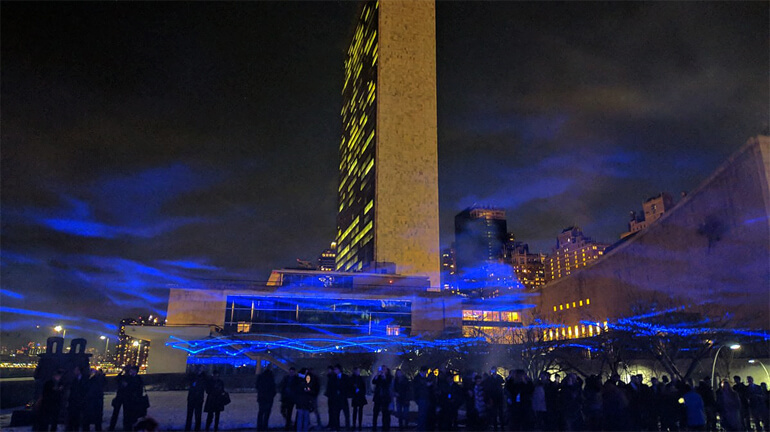
In his 2013 book, 10 Billion professor Stephen Emmott lays out an apocalyptic view of the future and discusses the possible resolution of the current problems we have. We have, in the past, avoided catastrophe by coming up with technological advantages capable of solving our immediate, short-term problems. Emmott points out five areas of technological research which we hope will solve the problems on the horizon.
1 Green Power. In 2012 the EIA (U.S. Energy Information Administration) predicted that global energy consumption would have to increase 48% by 2040. Renewable energy sources, which include wind-power, water-power, solar-power, wave-power, and bio-fuel currently account for only 11% or worldwide energy production [1]. They are currently being hailed in the western world as the long-term solution to our energy problem. What we fail to realize, though, is that in order for us to meet our growing energy needs in time with renewable energy sources, we’d have to embark on a worldwide global renewable plan right now. The change to renewable energy will be slow and gradual, as long as active “dirty” energy plant continue to produce most of our electricity. It is doubtful whether we’ll reach 100% renewable power by the end of the century, and even then, we will have released untold amounts of carbon dioxide in the meantime.
Furthermore, the most popular renewable energy, solar energy, has a few downsides. First of all, the photovoltaic cells used to capture solar energy require many rare elements, including Cadmium, Tellurium, Indium, Gallium, Selenium, Germanium, Ruthenium. All of these materials, says a 2015 article by Leena Grandell and Mikael Höök, are in short supply in the earth’s crust and will severely limit the use of solar power as a worldwide energy solution. A 2014 National Geographic article also states that the production of those photovoltaic cells produces large amounts of sodium hydroxide and hydrofluoric acid, and the process uses water as well as electricity, the production of which emits greenhouse gases. It also creates waste. That these problems could undercut solar’s ability to fight climate change, and the same can be said for other forms of renewable energy, which are very impractical to develop on a large enough scale to satisfy humanity’s growing energy needs.
2 Nuclear power, once hailed as a source of “infinite energy”, has now been cast aside as a global power solution. Nuclear power could potentially meet our energy needs in a very carbon friendly way, but is too expensive, unsafe, politically unpopular, and produces large amounts of waste which has to be decommissioned and dealt with. Apparently, the downsides are simply too many, especially considering the relative convenience of traditional energy plants.
3 Desalination. Another pressing issue in the next 100 years will be the lack of fresh water. As the population rises and more and more people move into the middle class, consuming more water per capita, global water needs will skyrocket. At the same time, rising global temperatures and consequent extreme droughts (that are already taking place in many parts of the world) will make fresh water much more insecure. Fortunately, we have an abundance of salt water. Desalination is a process which strips the sodium from sea water. Considerable advances in desalination technology could make fresh water much more accessible to millions of people. Unfortunately, an increase in desalination plants would have potentially problematic side effects: desalination is very energy intensive and produces a large amount of “waste” salt, which, if released back into the ocean can have a very harmful effect to the surrounding coastline. How we will provide enough water for a growing population is yet to be seen, but research seems to indicate that desalination plants will only be able to resolve a fraction of future water crises.
4 Geo-engineering is the process of undertaking planetary-scale engineering efforts to mitigate the worst consequences of climate change. Efforts include seeding the oceans with iron filling to absorb CO2, building giant umbrellas in space to deflect the sun’s rays, create “engineered” atmospheric brown clouds to block solar radiation, capturing carbon dioxide at source (power stations) and storing it underground. The problem is that geoengineering projects are largely unproven, they also have to be undertaken on a huge scale, which means they are extremely expensive, and potentially come with significant negative long-term effects.
5 A second green evolution. There is currently no way to feed a population to size of the one predicted in 2050. Not only are rising heat levels and increased droughts compromising millions of acres of land, but increased levels of meat consumption means that the same amount of land feeds fewer people (meat is incredibly energy-nutrient inefficient). In order to feed 10 billion people, we’ll have to drastically increase food output, some scientists claim that a combination of population growth and increased demand for resource-intensive dairy and meat products will cause worldwide food consumption to double by 2050, from today’s levels. An unprecedented increase. We absolutely won’t be able to meet those demands without immense scientific innovation, and it’s unlikely that that will come in time.
Professor Emmott demonstrates quite clearly that the means and scale with which we are currently working towards a green world are insufficient, if not laughable. It gives me hope to know that there are great minds today thinking of a better future for us all, rather than a worst one. I recently found another individual who imagined such a world and took actual steps to bring it into fruition. Jacque Fresco was a futurist and self-described social engineer who saw the direction we were heading in and dedicated his life to writing an alternative story (until his death in 2017). He was an advocate of the global implementation of a socioeconomic system which he referred to as a “resource-based economy”.
The World of The Future
Fresco’s brainchild, the Venus Project, proposes the city/transportation systems of the world. He is frequently criticized as a utopic thinker, but as Morten Grønborg, of Copenhagen Institute for Futures Studies, points out, “… this visionary idea of a future society has many characteristics in common with the utopia. … the word utopia carries a double meaning, since in Greek it can mean both the good place (eutopia) and the nonexisting place (outopia). A good place is precisely what Fresco has devoted his life to describing and fighting for.”

The Venus project “proposes a circular city plan that would utilize the most sophisticated available resources and construction techniques. All cities will be designed to operate with the minimum expenditure of energy using the cleanest technologies available, which will be in harmony with nature to obtain the highest possible standard of living for everyone” as stated on their official website. The idea in its core is that of sustainability and equality.
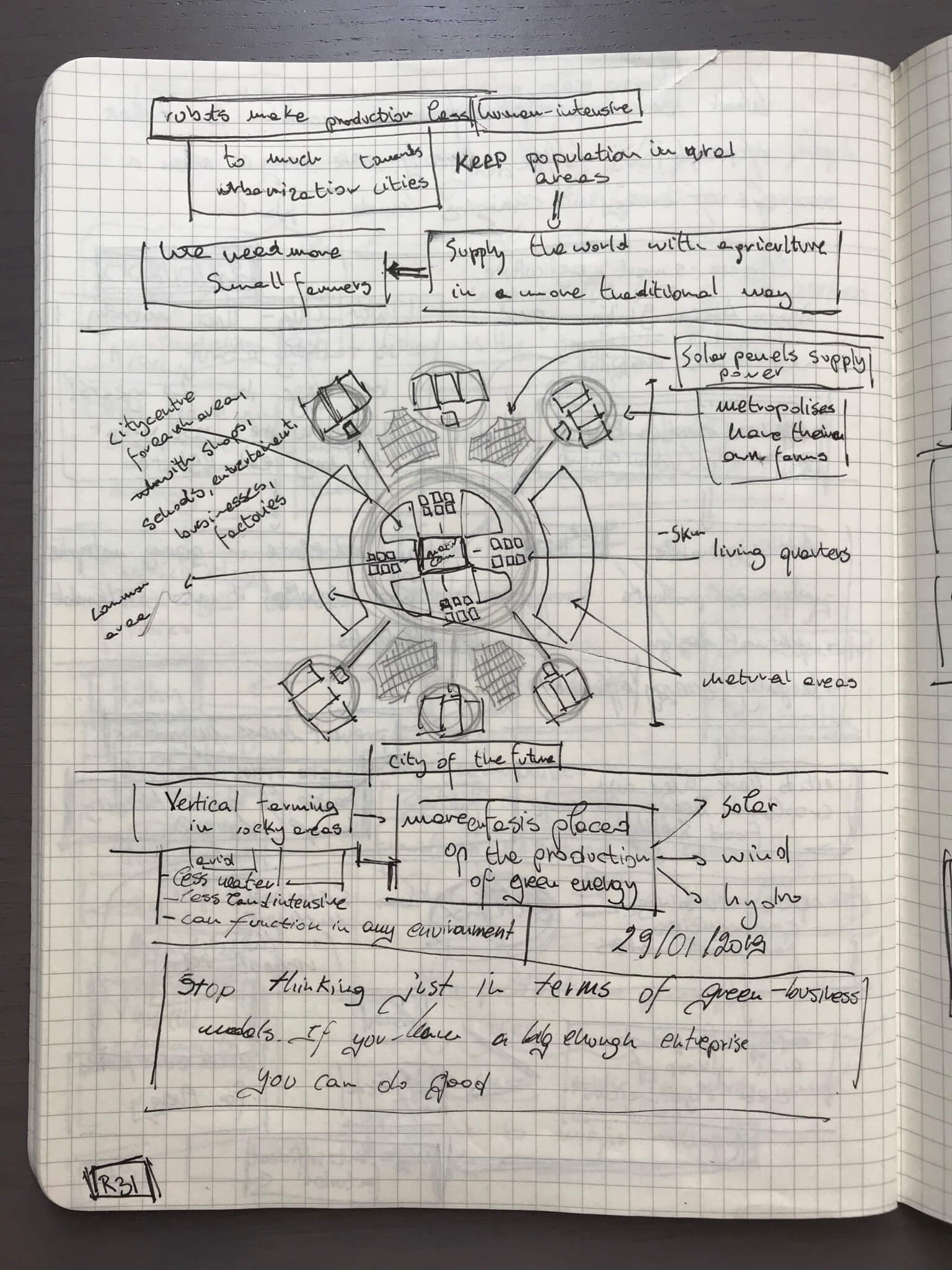
Before coming across the concept of the Venus Project, I had myself become interested in the concept of a new type of community; one that could sustainably shelter its inhabitants from the problems of the 21st century and pursue a better future than is created by the current model of human living. When I came across Fresno’s ideas I was extremely intrigued, here was a man who had spent his life working on the exact project I been thinking about. Details I hadn’t even begun considering were laid out in minuscule detail, such as the process through which one community would communicate with another, or supply enough food for its inhabitants in all environments. And while it’s true that the technical planning is important, there are significant alterations that need to be made before a system like this (which I support) can exist on a sufficient scale to actually make a difference.
First of all, a few words on Fresno’s resource-based economy. It essentially depicts the abolishment of all private wealth and the stockpiling, preservation, and allocation of all resources equally and universally. Now I should note that Fresno adamantly stated that his intention was not to defend or create a communist system, but it certainly seems to me that in its essence his system is communist, in the strictly etymological sense of all wealth being commonly owned and divided. Stalin’s Russia, Mao’s China, Ho Chi Minh’s Vietnam are a constant reminder to me that anything can work in theory, but not always does in practice. As we are probably centuries away from developing hard AI, which according to Fresno is what will allow us to remove human error (and thus the risk of ideological breakdown) from the system, it seems unfeasible to me that the exact system ideated by Fresno could be implemented. Furthermore, the resource-based economy of the Venus Project is such a radical idea when compared to the current system which we live in that I find it absolutely dreamlike.

That being said, we have to decide, as a collectivity, to live differently, and expect different things from those of power. The individual efforts made by many since the first green movement in the 1960s are not even close to enough and are more like trying to put out a bonfire with a spray bottle, while ten other people add gasoline – research shows us that of all anthropogenic (created by humans) carbon-dioxide emissions, seventy percent of it occurred in the last 50 years, or since the 60s. What is necessary is massive, wide-scale action, and it is unclear to me how any individual person, organization or government, is going to be able created on the necessary scale.
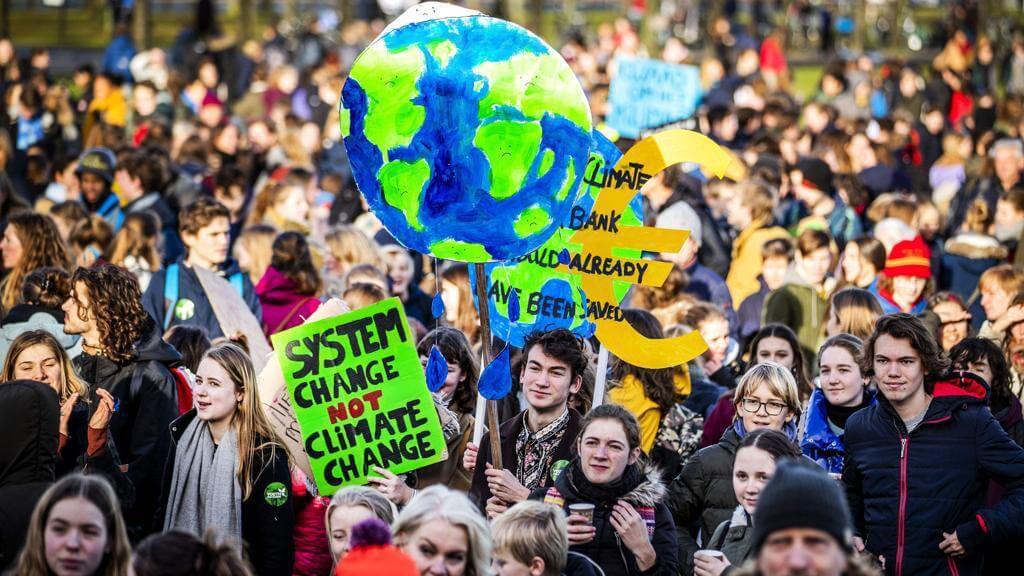
Instead, I am hopeful that my generation, and our children’s, will be able to change and unite to take the steps to avert the catastrophe before it is too late. The world-wide school strike inspired by youth environmentalist Greta Thunberg, which involved over 1.4 million students, is proof enough that times are changing. The day may come when we are ready to fully open our eyes and see the future in store for us, and I hope that at that point the implementation of a massive plan may be possible.
One begins by assessing the geopolitical changes expected to occur during the next hundred years; that’s more or less the time frame under my direct (during my life) or indirect control (through an organization, business or movement). Past a hundred years, things just become too unsure, and it’s impossible, in my opinion, to lay out a plan that is still coherent. Especially in this fast-changing world.
We know for sure that the global population still has a long way to grow before reaching an inevitable point in which the carrying capacity of the planet for human life is exhausted (or indeed decimated). The median estimate for future growth sees the world population reaching 8.6 billion in 2030, 9.8 billion in 2050 and 11.2 billion by 2100, according to a 2017 study conducted by the United Nations. The overwhelming amount of this growth in Asia and Africa – Africa, in particular, is expecting unprecedented economic growth along with its increasing population. All this, however, comes with increased instability and given the prospectives on climate change, and their effects on every aspect of life, we can expect regions of Africa and Asia to increase in geopolitical instability rather than decrease as the populations and per capita income increases.
This, accompanied by a radical increase in food demand that cannot be met (click here to see why ) will inevitably lead to a situation in many parts of the world of all-out-war over resources. The same can be said of water and electricity. The latest United Nations World Water Development Report, released just ahead of World Water Day on March 22, warns that, by 2030, only 60 percent of the world’s demand for water will be met by existing resources at the current rate of use. That will leave 40 percent of the population without access to the water it needs. Obviously, when there is shortage, there is conflict. We are, after all, not much more than warmongering apes, with varying levels of intelligence and compassion (less in the case of the current US president).
We, therefore, will soon be living in a world rife with conflict and instability and characterized by an abject lack of resources. Famine will become common-place in many parts of the world, and conflict and disease will accordingly flourish like some sick, and perverse plant from the “soil” of that scarcity, directly contradicting the preposterous idea of Yuval Noah Harari which is the presupposition of the “million-copy-seller” Homo Deus.
“Over the past century, humankind has managed to do the impossible and rein in famine, plague and war. Today, more people die from obesity than from starvation; more people die from old age than from infectious diseases; and more people commit suicide than are killed in war.”
-Harari, Homo Deus, 2016
What I believe Harari was unwilling, or unable to acknowledge is that these problems can be eliminated almost completely in a period of abundance such as that experienced by mankind thanks to the advent of fossil-fuel. But when that abundance is no longer present, the world population will be more than 10 times greater than before the industrial revolution, and their lifestyle will require many more resources, resources that simply do not exist.

Unfortunately, it does not seem to me like most people fully realize how dire the situation is. It is so easy, during a period of abundance, in fact when all we have known or seen is abundance, to convince oneself that the situation will persist into the future. And so we will do nothing, or certainly not enough. Inevitably, therefore, humankind will have to face global resource scarcity at the same time that it begins to feel the first real calamities caused by climate change, which will do nothing but exacerbate an already very serious situation.
I am, as a result of these beliefs, a stark realist, to not say pessimist. I cannot hope that we will be able to avert some degree of catastrophe: what I have seen has not shown me that we will have the technological means to satisfy our needs without emitting further CO2, nor that we will radically change our lifestyles and diminish our birth rate. No, as long as there are cheap airplane flights to warm places we as consumers will use them. Because after all, many of us have been touched in very inconsequential ways by climate change. As I stated previously, the best case scenario seems to me to be a large-scale mobilization by the people to demand a different kind of reality, and even that I do not foresee gaining the necessary momentum before 2050 at least, by which time untold damage will have been done and we will be far past the point in which we could have avoided disaster. Decades past it. A plan, therefore, which includes the Venus Project within its blueprint, should take into account that its role is not only to prevent further damage to the environment but also to shield the human spark from the consequences of the damage that has already been done.
In saying “shield the human spark,” I feel like an important clarification is in order. As a realist, it is my belief that our society and all its institutions will look much, much different than it does right now. One of the downsides of the extraordinary complexity of modern society, with supply chains spanning the whole globe and unprecedented interconnectedness and interdependence, is that the entire structure is much more vulnerable to systemic collapse than, say, a small feudal castle and its surrounding peasants.
It is not just because I live in Venice Italy, which is tragically destined to share the same fate as many small island nations such as the Maldives and the Fiji islands, that I have such a negative outlook on where we will collectively be, but rather the simple, undeniable fact of the resource crisis we are about to face. I find it unwise to expect that the developed world will be unaffected by the events of the next hundred years. Although I do agree that the degree to which we are affected will depend on our ability to adapt to a shortage, and also upon our willingness to forcefully keep out the millions of climate refugees who will come en mass into the developed world in upcoming years – fleeing from famine, diseases, conflict, or most likely a combination of the three.
Whatever the case I must recognize that by the time the famines start, diseases flourish, and war breaks out in the less stable (and therefore more vulnerable) parts of the world, it will already be too late for many people. We are already unable to feed millions of people in poorer parts of the world, what do you expect to happen when heat waves bake crops, droughts and floods wipe out many more miles of land, and food demands has increased radically? The inevitable result was coldly laid out by the scholar Thomas Malthus in the early 18th century.
Famine seems to be the last, the most dreadful resource of nature. The power of population is so superior to the power of the earth to produce subsistence for man, that premature death must in some shape or other visit the human race. The vices of mankind are active and able ministers of depopulation. They are the precursors in the great army of destruction, and often finish the dreadful work themselves. But should they fail in this war of extermination, sickly seasons, epidemics, pestilence, and plague advance in terrific array, and sweep off their thousands and tens of thousands. Should success be still incomplete, gigantic inevitable famine stalks in the rear, and with one mighty blow levels the population with the food of the world.
— Thomas Malthus, 1798. An Essay on the Principle of Population. Chapter VII, p. 61
This terrifying reality seems to have been avoided towards the end of the 20th century as the so-called Green Revolution allowed for agricultural output to increase enough to compensate for the skyrocketing global population. However, the Green Revolution was, in essence, the development of fertilizers and pesticides – in that way we “paid” the extra calories in the increased yields will chemicals, chemicals that are now in short supply. Without a miraculous breakthrough in farming technology, we will not be able to achieve the radical growth in food demand of a more populous world and will instead witness the dreaded “Malthusian Check”…
The reason why I allowed myself to digress for so long is that I wanted to make it perfectly clear that I have no hope that humanity in its totality will get through the next few centuries unscathed. It is unfeasible to think that because it is already too late to check our population growth (and carbon emissions) on our own. Rather, just like rabbits who overpopulate their natural habitat and poison its air, we will be subject to a cataclysmic die-off that will bring the population back to a balance. That is why the goal of society conceived by Fresno should be less that of saving all of humankind, and more of acting as an arc for humanity and its many treasures, or the aforementioned “human spark”.
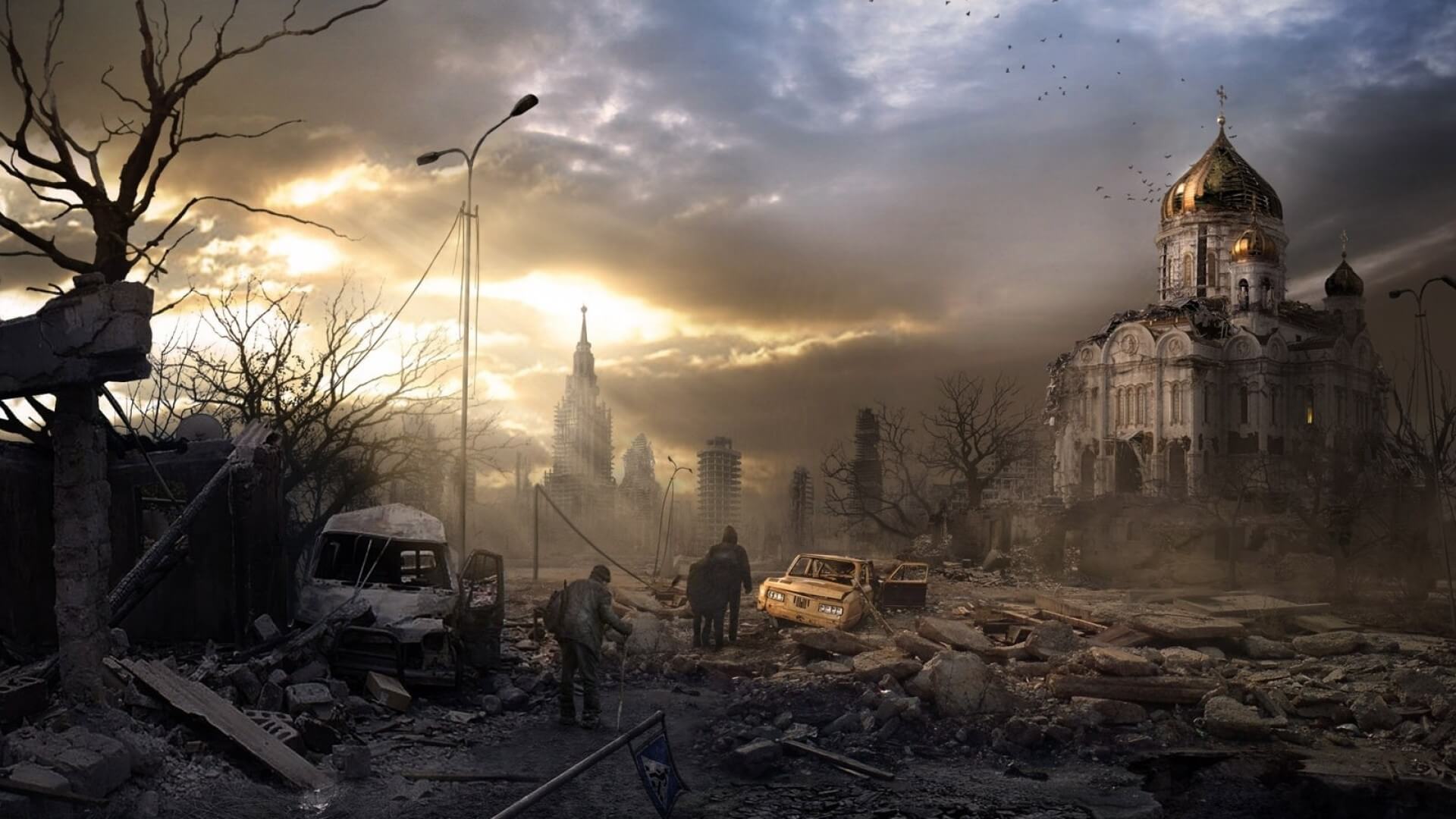
A flood is coming, and it is of our own making. When the dust settles, I believe will be facing a much different world than before, and will have to adapt to it. But first, it is indispensable to maintain enough political, social, and economic order to be able to do so in a dignified manner, without returning the dark age among the charred remnants of our old society. And that will only be possible if we implement a system which sustains, defends, and organizes at least some of us through what I am convinced will be a few very trying centuries for the human race.
Implementation
My main critique of Fresno’s work is the lack of an actual plan to implement it. It says in their main website that the Venus project will come into implementation as the monetary system begins to fail. One of the cornerstones of the organization’s findings is the fact that many of the dysfunctional behaviors of today’s society stem directly from the dehumanizing environment of a monetary system. They say that automation will do away with jobs and produce a moneyless, jobless workforce without any buying power. The three proposed phases for the proliferation of the Venus Project are
- The construction of a 21-acre research center in Venus, Florida to help present the proposals of The Venus Project. This center has already been built in Venus Florida
- The production of documentaries to help introduce this direction to the world. Two major documentaries have already been completed: Paradise or Oblivion and The Choice is Ours. Phase Two also includes a full-length feature film that will depict how a world embracing the proposals advanced by The Venus Project would work.
- The construction of an experimental research city to test the designs and proposals of the Venus Project.
Included in the footnotes of their proposals is the note that “A circular city would be a transitional phase and could evolve from a semi-cooperative money-oriented society to a resource based economy. This could be the prototype for a series of cities to be constructed in various places throughout the world.” I do not feel however that that is a well thought out, or at the very least, an effective proposal, if one’s goal is the global-wide implementation of a system which is radically different from the one in place today.

The Venus Project, or at least parts of it, show a lot of promise in ensuring mankind not only survival and sustenance but the chance to flourish as a species. But we have an obstacle in our way. I believe that the Venus Project could help us weather that storm. But in order for that to happen someone needs to come up with an alternative plan.
And implement it.
When one breaks down the Venus Project’s implementation plan, one finds that it is essentially a plan to gather support and increase awareness before beginning the construction of tested cities around the world and relocating people to live there, all using funding of people reached in the first phase of support gathering. And that, in my opinion, is like having no plan at all. Firstly because people in a circular city will have to adapt to a society which is much different from the one we live in today, as it will also be void of many of the modern luxuries which exist only thanks to fossil fuels, and which the Venus Project’s plan does not include in its cities. Therefore gathering actual support from people to voluntarily live in these cities despite the (temporary) abundance of modern society will be hard-going, at least on the scale needed to make a real difference.
The main reason for the redundancy of the current plan, however, is simply that expecting to build thousands of highly costly and advanced cities solely through funding is absolutely preposterous. There is simply no way to collect enough funds to build more than a handful of these cities through funding, and even that is farfetched if we consider the scale and complexity in Fresno’s designs. Even one city would reasonably require tens (if not hundreds) of millions of dollars to build, and in order to reach even a billion people worldwide, one would have to build thousands of such cities. The required resources do exist, but will not be obtained through donations and funding, which as per the upper half of the picture below would see the Venus project completely cut off from the market system.
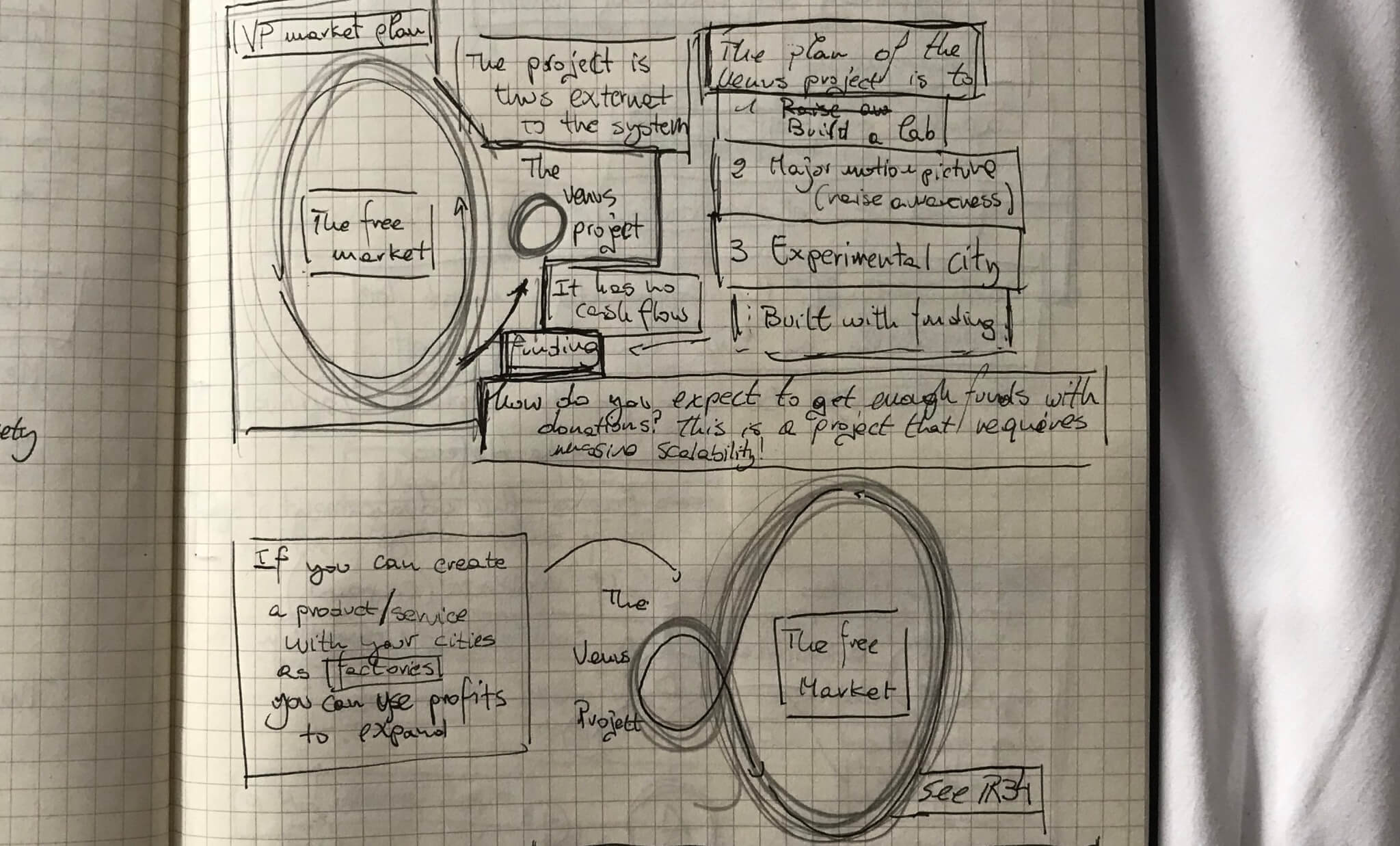
Instead, I imagined what the Venus Project might look like if it were to be conceived and implemented as a company. As per economics 101, a company is an entity capable of generating cash flow by creating a product or a service. Every company is an independent entity, and yet money flows out of the system and though it like electricity through a lightbulb. If more money flows in than flows out, the company is at a net profit. If more flows out than in, the company is at a net loss.
My idea for the implementation of the Venus Project, or a similar variant of the same nature, is to devise the entire project as a company which creates a product or service. In that way, each city can be viewed as an independent factory city, albeit a factory with a school, solar panels, and its own farms. The profit made by a singular city will be used to build the next one, and if the model for growth works correctly, these factory cities should increase in number at an exponential rate. This can only happen, of course, if there is enough demand to meet the increasing offer of the company, however, it seems to me that in the next century we will meet with an unprecedented level of demand as the population continues to climb and resources dwindle.
Another problem, one might note, is to find enough individuals to populate these cities. I would point out however that in many areas of the world, over the next century, a city capable of generating its own electricity, distilling its own water, growing its own food, and educating and curing its inhabitants will be seen as an oasis. People will line up outside such cities to get in and will voluntarily offer their work if the alternative is to stay outside and succumb to starvation, conflict, or curable diseases. For this reason, it seems likely to me that the geographical areas in which to first create these cities should be those with a rapidly growing population and the accompanying risk of instability and famine.
Another aspect to compensate for is that some geographical regions are barren and void of natural resources while others have many. One city might, for example, be situated in an ideal location to grow crops, whereas the surrounding cities might be situated on a desert terrain unfit for agriculture. In this case (which could also apply to resources such as water and electricity), the agricultural city would supply crops to its neighbors, thus forming a linked mesh of interconnected cities that are stable and impervious to droughts and natural disasters.
It is, however important that each city have the ability to provide for its own resources for the added stability it provides to each independent location. This is one of the flaws of modern society. Everything, from the growing of crops to the production of t-shirts, is decentralized to improve efficiency. While it is true that one big farm can provide more crops than one hundred little farms which together cover the same amount of land, if the big farm fails no one eats, whereas if the ten out of a hundred little farms fail, the remaining farms can try to compensate for the reduction in food production. This is actually not a huge issue today in developed or even in developing countries, simply because of the current abundance of the system, again thanks to fossil fuels. Economists, however, have calculated that the world’s economy could be hugely affected by climate change and by the end of our fossil fuel reserves, and estimate that the global economy could be much smaller than it is today in a post-fossil fuel landscape. And at that point, we will no longer be able to afford the instability of centralized agriculture, water purification, or energy production.
More than anything, now is the time to begin, while the world economy is still booming, while conflict, famine, and disease are at a historic low. In a way my suggestion to use the excess money, currently present in the system thanks to fossil fuels, to build these cities means building the future with the mistakes of the past, and until we are ready to wake up, and confront those who are ruining the world, I can’t see why we should not at least ensure that no matter what happens, the miracle of civilized society will survive climate change and all its horrors. That, as far as I’m concerned, is a worthwhile goal.
Other sources:
10 Billion by Stephen Emmott
https://asiafoundation.org/2015/03/25/south-asias-water-crisis-a-problem-of-scarcity-amid-abundance/
https://www.theguardian.com/news/2015/apr/08/can-world-economy-survive-without-fossil-fuels
https://www.thenation.com/article/new-abolitionism/
